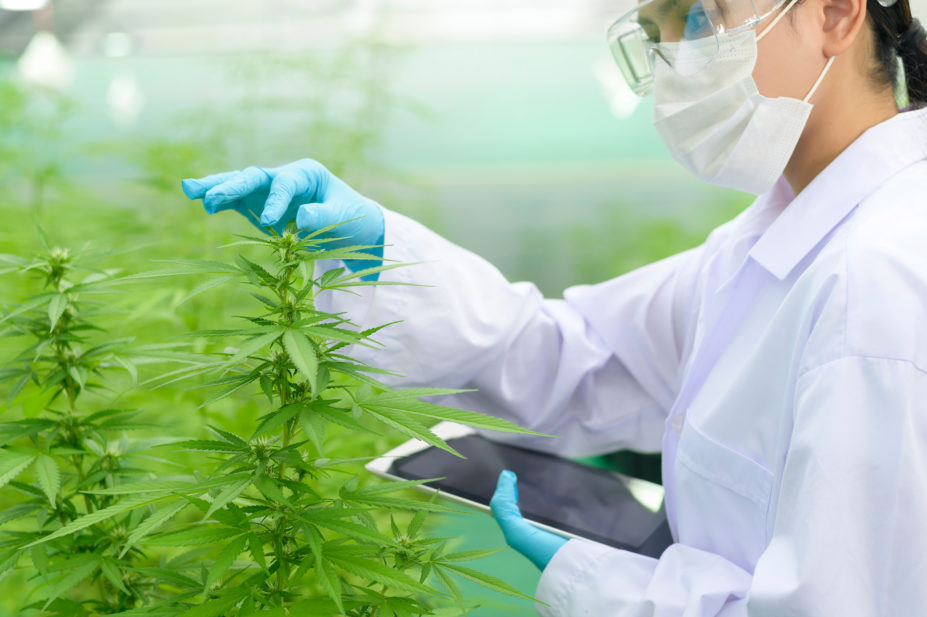
Shutterstock.com
Cannabinoid Education 360, from GW Pharmaceuticals — part of Jazz Pharmaceuticals — is an online platform of evidence-based, balanced educational resources highlighting the science of cannabinoids, the research behind cannabis-based medicines, and the laws and policy frameworks that regulate them.
In a bid to encourage conversations about cannabis and cannabinoids from a scientifically supported perspective, Cannabinoid Education 360 held a virtual ‘Meet the expert’ session at the XXV World Congress of Neurology (WCN), which took place on 3–7 October 2021, to provide clarity around this important yet complex field of medicine.
Clarifying cannabis confusion
Hosted by Professor Eugen Trinka (chair of the Department of Neurology at Christian-Doppler-Klinik, Paracelsus Medical University Salzburg) and Professor Alessia Ligresti (research associate professor at the Institute of Biomolecular Chemistry of the National Research Council of Italy), the session focused on the pharmacology but also provided a brief summary on different categories of cannabis-based products and medicines in relation to consistency, accessibility and supporting evidence.
Ahead of the presentations, Professor Trinka asked Congress delegates to vote in a poll on whether they thought medical cannabis products — which some national authorities have allowed the prescription of — are different from cannabis-based medicines that are approved by the European Medicines Agency (EMA) or US Food and Drug Administration (FDA). There was a clear result — 100% of responders said that they ‘don’t know’.
With the number of cannabis-based products available worldwide increasing, and what he called “a tsunami of misinformation spreading online” making it extremely difficult for the public and healthcare professionals alike to remain well informed about cannabis products, Professor Trinka said this result illustrated the reason why sessions such as this are so important.
“This is why we started this initiative, because healthcare professionals must be aware of the differences between cannabis products and consider the quality of evidence when we make decisions with the patients and that’s what we do every day,” he said.
Cannabis-based products
Helpfully, Professor Trinka followed up with a snapshot of cannabis-based products that are becoming increasingly relevant in healthcare. These contain chemicals from the cannabis sativa plant and include phytocannabinoids, or their artificial derivatives, synthetic cannabinoids and fall into three main product groups.
The first group is cannabidiol (CBD) containing consumer and food products. There is a huge number of commercially available products containing CBD but, stressed Professor Trinka, there is a “lack of manufacturing oversight” that can lead to variability in chemical content. Furthermore, there is virtually no clinical data supporting the efficacy and safety of these consumer and food products.
The second group is the non-regulatory approved cannabis-based products. Otherwise known as ‘medical cannabis’, these are prescribed for medical purposes under the direction of a clinician. Although this makes it sound as if these products would have more clinical safeguards around them, Professor Trinka said many of them have “a lack of robust clinical data” and a “variability” of content, alongside no randomised control trial results and pharmacovigilance monitoring that varies country by country.
The third group of cannabis-based products is the highest standard, and these are the regulatory approved cannabis-based medicines, approved for use by medical regulators around the world such as the EMA and FDA. Good manufacturing practices ensure consistency between the batches of these products so prescribers and patients can be confident in exactly how many milligrams of cannabinoids and other substances they contain. There is also supportive data from preclinical and clinical trials that has been reviewed by medicines regulators, and is how these drugs are approved medicine for certain indications.
Despite these clear delineations, Professor Trinka’s next audience poll on delegates’ level of confidence about their understanding of the pharmacology of cannabinoids showed none (0%) were ‘very confident’, only 18% felt ‘confident’, 53% were ‘a little confident’ and almost one third (29%) said they were ‘not at all confident’ on this topic.
Cue Professor Alessia Ligresti — research associate professor at the Institute of Biomolecular Chemistry of the National Research Council of Italy — to help lift the veil a little further on the pharmacology of cannabinoids.
The pharmacology of phytocannabinoids
Phytocannabinoids are mainly produced in the flowers and upper leaves of the female cannabis plant. Delta-9-tetrahydrocannabinol (THC) and CBD are the two best studied types, but there are other phytocannabinoids such as cannabigerol (CBG), and cannabidivarin, which are among many others that are being actively investigated.
According to Professor Ligresti, the important point about phytocannabinoids is that each has its own distinct pharmacology, which may cause different and sometimes divergent effects in the body as a result. The vast majority of these effects elicited by phytocannabinoids owing to their interaction with the so-called ‘endocannabinoid system’ — a pleiotropic pro-homeostatic system that often appears to be deregulated and disrupted in many pathological conditions.
Originally, the endocannabinoid system’s homeostatic rules were summarised as ‘relax, eat, sleep, forget, protect’, but it has become clear that the system can regulate many other physiological processes, including some outside of the central nervous system, such as neurogenesis, nociception, mood, motivation and reward, lipid and glucose metabolism, inflammation and cell proliferation — which suggests how huge the potential of the endocannabinoid system could be as a therapeutic target.
However, echoing the central theme of this Congress session, Professor Ligresti emphasised that to fully unlock this potential we need a better understanding of how it works.
The endocannabinoid system
The endocannabinoid system is driven by endocannabinoids, specific receptors and regulatory enzymes.
Anandamide and 2-arachidonoylglycerol (also known 2-AG) are the two main endocannabinoids and were the first to be discovered. These endocannabinoids are produced on demand and modulate other signalling systems.
The body’s cannabinoid receptors have two main subtypes: CB1 and CB2 are G-protein-coupled receptors, with CB1 mainly expressed in the brain — although a variety of peripheral tissues also express this receptor —and CB2 mainly expressed on immune system cells, with their distribution in neurons and glial cells also recently confirmed. Endocannabinoids can also bind via non-cannabinoid receptors, and this binding can likely mediate some of the effects.
Fine control of endocannabinoid levels is required to help maintain homeostasis in response to change, and this complicated system is kept in balance via what Professor Ligresti called tightly regulated “enzyme machinery”, which guarantees adequate levels of endocannabinoids within the brain when they are really needed. Diacylglycerol lipase and monoacylglycerol lipase are the two main enzymes involved in the biosynthesis and degradation, respectively, of 2-AG.
We also know that phytocannabinoids and endocannabinoids share the same molecular targets, which means that phytocannabinoids can interact with classical cannabinoid receptors but also with non-cannabinoid receptors. In fact, THC is a partial agonist at CB1 and CB2 receptors — although Professor Ligresti said experts are still debating the partial rather than the full agonist role — but we do know that it competes with the endocannabinoid system for binding. On the other hand, phytocannabinoids, such as CBD and CBG, are very weak ligands for the CB1 and CB2 receptors, primarily interacting with other receptors such as the serotonin and the vanilloid receptor.
The tip of the iceberg
This “complexity and promiscuity”, according to Professor Ligresti, indicates that further research into the effects of phytocannabinoids binding to specific receptors is required to fully unlock their therapeutic potential. Calling it “just the tip of the iceberg”, she said the wider endocannabinoid system encompasses more than 100 endocannabinoid-like molecules, as well as additional enzymes and additional receptors. As a result, behind the canonical endocannabinoid system phytocannabinoids and endocannabinoids share signalling, redundancy and promiscuity, making it challenging to define the precise mechanism by which cannabinoids mediate their effects on the body.
What is clear is that the endocannabinoid system is an essential and complex system that affects a variety of physiological processes, and for this reason cannabinoids are a promising therapeutic target that clearly warrant further research to fully unlock their therapeutic potential.
Conclusion
Professor Trinka wrapped up the session with a final poll, asking delegates to reconsider how confident they now felt about the pharmacology of cannabinoids. Although no one professed to be ‘fully confident’, 62% said they were ‘a lot more confident’ and 38% were ‘a little more confident’ and, reassuringly, no one (0%) said they ‘still don’t know anything’.
Despite this uptick in confidence, Professor Trinka once again emphasised that the variability of content consistency, and evidence behind so many of the cannabis-based products available around the world, remains a key factor that healthcare professionals have to be aware of in order to make the right decisions for patients.
“I think we still need much more research,” concluded Professor Trinka. “Basic research on the complex pharmacology of cannabinoids, and a lot of clinical research to bring these to the good of the patients.”
Key points
- There are many different types of cannabis-based products on the market, which vary in terms of the content consistency;
- They also vary in terms of evidence supporting their medical use: from the highest grade of evidence, which is randomised controlled trials, to the lowest level of evidence, which is nothing;
- Each phytocannabinoid has its own distinct pharmacology, which may cause different and sometimes divergent effects in the body;
- Clinicians need to be aware of the differences between cannabis products and consider the quality of evidence when making decisions with patients.
For further information: For more educational resources, visit: www.cannabinoideducation360.com
This article was commissioned and fully funded by Cannabinoid Education 360 developed by GW Pharmaceuticals, part of Jazz Pharmaceuticals. The content was developed by The PJ Content Studio in association with GW Pharmaceuticals. GW Pharmaceuticals has reviewed the article to ensure factual accuracy in relation to compliance with industry guidelines.




